Muchas hormigas en los verdes, no bueno
Jim Alwine, Stockton Golf & Country Club, Stockton, CA:
 "Hormigas are ants. That is a new Spanish word for me, taught by my always helpful, bi-lingual staff. Ants on the greens have been a minor problem for a full year. The fourth green has definitely been the worst one with up to twenty small mounds built in clusters. Each day they are mowed down and rolled over, but they are reconstructed to their former glory by mid-afternoon. I teased some members that I hired these ants to perform some minor aerification, but they are now becoming a problem that is more difficult to control than I would have guessed. "Hormigas are ants. That is a new Spanish word for me, taught by my always helpful, bi-lingual staff. Ants on the greens have been a minor problem for a full year. The fourth green has definitely been the worst one with up to twenty small mounds built in clusters. Each day they are mowed down and rolled over, but they are reconstructed to their former glory by mid-afternoon. I teased some members that I hired these ants to perform some minor aerification, but they are now becoming a problem that is more difficult to control than I would have guessed.
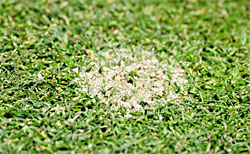 We tried the common insecticides that we normally spray about two times a year for cutworms. The ants were knocked back for a few days and then started at it just like before. Recently, the number of mounds have been increasing and they are starting to show up on most of the greens, not just a couple isolated areas. I tried spot spraying, but the surface sprays would only last for two days. We tried the common insecticides that we normally spray about two times a year for cutworms. The ants were knocked back for a few days and then started at it just like before. Recently, the number of mounds have been increasing and they are starting to show up on most of the greens, not just a couple isolated areas. I tried spot spraying, but the surface sprays would only last for two days.
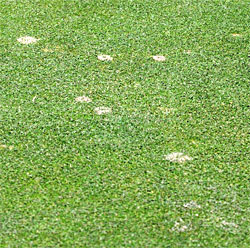 My search for a cure led me to TurfNet, as is often does, and I searched The Forum to see what I could find. There has definitely been a superintendent who has seen and resolved this problem before me,so there is no need to reinvent the wheel. Sure enough, others had the same problem and went through the same process to eradicate las hormigas. I was pointed in the direction of a USGA funded study at the University of Kentucky, 'Nuisance Ants on Golf Courses' by Reid M. Maier and Daniel A. Potter. My search for a cure led me to TurfNet, as is often does, and I searched The Forum to see what I could find. There has definitely been a superintendent who has seen and resolved this problem before me,so there is no need to reinvent the wheel. Sure enough, others had the same problem and went through the same process to eradicate las hormigas. I was pointed in the direction of a USGA funded study at the University of Kentucky, 'Nuisance Ants on Golf Courses' by Reid M. Maier and Daniel A. Potter.
The troublesome ants are now much fewer in number and no longer marking up the putting greens. The turf that was thinned or scalped due to the mounding will heal up in a short time and look just like ball marks that were not repaired. Thanks to golfer etiquette, we've been pretty good in that category for a few weeks now. During his daily setup duties, Bert will keep an eye on the ant mounds and treat them as soon as they appear.
Visit Jim's blog at sgccturf.blogspot.com/
|
 |
Hand watering vs syringing
Shane Lohman, turfgrass intern, Oakland Hills Country Club, Bloomfield Hills, MI:
Sadie's Zen Rules

Rule #8. Know where you're headed. |
 "Hand Watering and Syringing are two very essential watering practices used on greens during high stress periods. "Hand Watering and Syringing are two very essential watering practices used on greens during high stress periods.
Hand watering is normally done in the morning with the sole intent to move water down into the root zone for uptake by the turf.
Syringing is typically done during the midday heat to cool the leaf tissue and to remove sugars released during photosynthesis. Syringing the turf is a light application or misting that does not allow the water into the root zone.
Both of these techniques are of vital importance in maintaining consistent dry surfaces without the use of sprinkler heads. These practices allow the application of water to go exactly where it is needed.
Hand watering and/or syringing cannot be scheduled around play, and can occasionally cause some minor inconveniences to the players. Not allowing these timely needed cultural practices to avoid disrupting play can lead severely stressed turf or even turf loss.
Visit the Oakland Hills blog at ohccturf.blogspot.com.
|
 |
Preparing for the Heat
Garrett Luck, North Shore Country Club, Mequon, WI:
 The cornerstone of the maintenance program at NSCC may be most appropriately described as taking all necessary steps to prepare for the heat of the summer. This general tenet may be easily lost on most golfers since Wisconsin summers often seem way to short. In fact, we focus our maintenance practices around preparing the course to withstand the difficult summer conditions that usually occur from July 4th to the middle of August. The cornerstone of the maintenance program at NSCC may be most appropriately described as taking all necessary steps to prepare for the heat of the summer. This general tenet may be easily lost on most golfers since Wisconsin summers often seem way to short. In fact, we focus our maintenance practices around preparing the course to withstand the difficult summer conditions that usually occur from July 4th to the middle of August.
Make no mistake that even though we often receive favorable growing conditions for much of the early summer and fall, this six week stretch of weather can be especially brutal. Often times, as turf managers, we see increased disease pressure, soil moisture problems caused by too much or not enough precipitation, equipment and personnel fatigue caused by long days at work, and increased traffic stress caused by golf carts and player traffic to name a few.
In order to overcome these stresses, we tailor our maintenance programs to offset them. Critical maintenance practices such as aerification, sand topdressing, a balanced nutrition program for the turf, preventative application of plant protectants, drainage installation, and irrigation system maintenance highlight some of the inputs required to keep a course in top condition throughout the stressful summer months.
Once we reach this time of year, our practices our evaluated on a daily basis to ensure that all necessary steps are taken to care for the turf at NSCC. Seemingly simple steps such as daily movement of the holes on greens to evenly distribute foot traffic and tweaking of mowing heights on putting surfaces assist in caring for the turf.
As we are about to embark on the hottest stretch of weather to date, the golf course maintenance staff has intensified its preventative maintenance measures. A few examples are highlighted below.
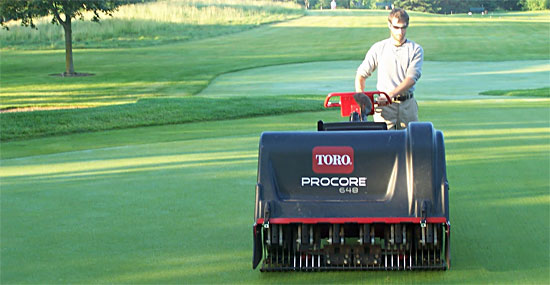
You thought aerification means big holes and bumpy greens? Not true, you probably didn't even notice that we completed an aerification process commonly referred to as "venting" last week. Instead of pulling larger diameter cores, the golf course staff poked the greens with very small, solid tines in order to improve air movement within the soil profile.
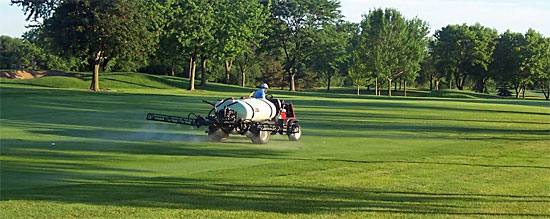
In order to combat prolonged periods of dryness, the golf course maintenance staff applied a combination of soil wetting agents which will allow the turf to maximize the amount of water applied to the turf.
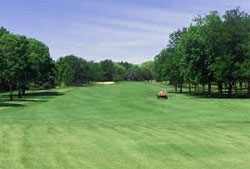 In an effort to better analyze which products are best suited and most cost effective, the 5th fairway on the Blue Nine was sprayed with multiple wetting agents. Through continual evaluation we will be best equipped to determine the best product for the dollar on next year's purchases. In an effort to better analyze which products are best suited and most cost effective, the 5th fairway on the Blue Nine was sprayed with multiple wetting agents. Through continual evaluation we will be best equipped to determine the best product for the dollar on next year's purchases.
Visit Garrett's blog at nsccgcm.blogspot.com
|
 |
After the Storm
Bryan Widmer, CGCS, Hilldale Golf Club, Hoffman Estates, IL:
 "Amazingly, we're pretty much back to normal on all fronts, only 48 hours after record (5+ inches) rainfall. There will be no cart restrictions and I think you'll find the course to your liking. "Amazingly, we're pretty much back to normal on all fronts, only 48 hours after record (5+ inches) rainfall. There will be no cart restrictions and I think you'll find the course to your liking.
Please, just be patient with us regarding green speed and bunker conditions. It's imperitive that we 'baby' the greens for several days (especially with more 90 degree temperatures on the way), and as you can see in the picture below, we're hard at work putting the bunkers back together after the extreme amount of water and subsequent washouts.
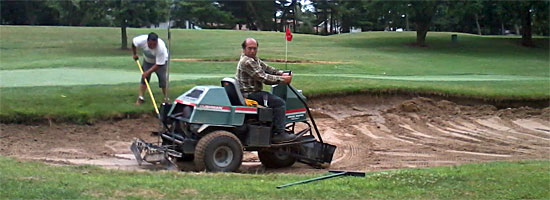
A heavy downpour plays havoc with bunker conditions. Sand gets contaminated with the underlying soil and therefore causes 'hard pan' type lies when playing bunker shots. Long story short: bunker consistency becomes an issue. We had five or six heavy rainstorms in 2010, and as many of you know, bunker consistency was very poor last year. So please bear with us as we correct problems left over from an extreme rain event. Thanks and I'll see you on the course!"
Visit Bryan's blog at widmergolfsupt.wordpress.com
|
 |
|
About our Blog Aggregator: Many superintendents are now hosting private blogs to better communicate with their golfers and/or members. Beyond local weather and course conditions, there is a great deal of information about projects, methodologies and techniques that would be of value to other superintendents — hence our Turf Blog Aggregator. As every blogger struggles occasionally with content, we also include posts intended to educate golfers about turf maintenance for others to use as a template for their own blogs.
TurfNet members: Want to share something from your blog? Send us the link.
Turf Blog Aggregator(TM) is a trademark of Turnstile Media Group.
|
|